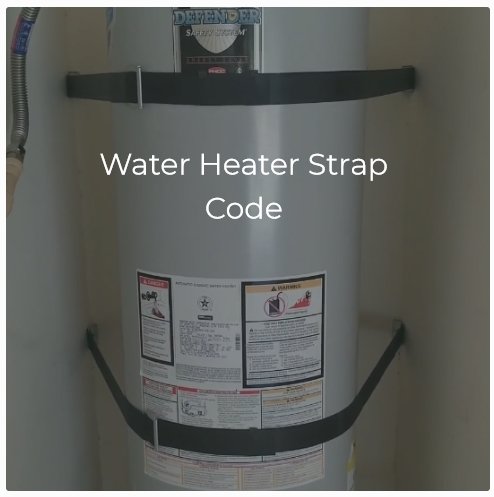It is essential for those who live in areas with high earthquake risk to understand the importance of securing their water heater by using a strap. During an earthquake event that causes intense tremors, the water heater may move heavily, so leaving the equipment without a firmly wrapped strap that is screwed safely to the planks may cause it to fall.
This is why each state in the U.S. has a water heater strap code that must be followed. Learn more about water heater strapping below.

Strap Code Washington State
As cited from the 2018 Washington State Plumbing Code, all water heaters in this state must be strapped or anchored to prevent them from stumbling or collapsing due to an earthquake. The straps must be set at the upper 1/3 and lower 1/3 of the water heater’s height.
For the lower strapping point, the distance between the strap and the strapping controls should be at least 4 inches (102 mm).
Properly securing your water heater is a critical step in earthquake preparedness, particularly in high-risk areas like Washington. Ensuring that the heater is strapped at the upper and lower thirds significantly reduces the risk of it toppling during a seismic event.
Strap Code Oregon
According to the Oregon Plumbing Specialty Code, water heater strapping requirements require that the heater be strapped or anchored with plumber’s tape or comparable materials.
The strap’s connector must come with washers to ensure it won’t pull through the straps. Some approved connectors include 0.25 inch wedge concreter anchor with a minimum length of 1.5 inches or #12 x 1.5-inch wood screw.
Strap Code Nevada
In Nevada, water heater straps are indeed required. Water heaters must be restrained with double straps within 1 foot of the wall stud. One strap should be installed within the upper one-third of the heater, and the other one should be fastened in the lower one-third. Allow at least 4 inches between the control knobs and the lower strap.
Read also: Rheem Tankless Water Heater Error Code 13
First-Hand Knowledge and Personal Experience
Having experienced several earthquakes, I understand the critical importance of properly securing water heaters. In one instance, I saw a water heater that wasn’t secured correctly topple over during a minor earthquake, causing significant water damage and posing a fire risk due to the disconnection of the gas line.
Water Heater Earthquake Strap Code
Since 1982, the Uniform Plumbing Code has laid out the seismic safety regulations for water heaters using straps. The guideline is required to prevent water damage, explosion, or fire in case the water heater unit overturns during an earthquake.
Your water heater tank is mostly already strapped, but you need to check if it’s done correctly because it uses the old water heater strap code, which is no longer recommended. The recommended water heater strapping procedure has been modified due to its proven ineffectiveness during the 1989 Loma Prieta earthquake and the 1994 Northridge earthquake events.
Here are the recommended approaches by experts:
- Secure it twice at the upper and bottom parts instead of at the tank’s middle or top.
- Instead of using plumber’s tape, use heavy-duty metal strapping. During both earthquakes mentioned above, many water heater units were forced through the plumber’s safe. This was mainly because the plumber’s tape uses slim metal that’s too frail to work effectively.
Seismic Strapping Requirements by State
| State | Strap Code Details |
|---|---|
| Washington | Straps at upper 1/3 and lower 1/3 of height; lower strap min 4 inches from controls |
| Oregon | Plumber’s tape or comparable materials; connectors with washers; specific anchor sizes |
| Nevada | Double straps within 1 foot of wall stud; upper and lower one-third strapping; 4 inches from controls |
| General (UPC) | Heavy-duty metal straps; avoid plumber’s tape; secure at upper and bottom parts |
Below are the recommended methods to secure the water heater:
- Create only narrow space between the wall and the water heater unit. If the distance is over an inch or two, you may use a wooden plank secured to the wall. This is important to prevent the unit from tipping backward.
- Circle the tank with heavy-duty metal strapping once and a half round. Begin by locating the straps behind the unit’s tank, to the water heater’s front part, and then back to the back part near the wall.
- Brace the strap to the wooden plank or to the wall by using lag screws that have an oversized washer in the size of 0.25 x 3 inches. In case the unit is secured right to the concrete, the screws can be replaced by 0.25-inch expansion bolts.
- Use flexible connectors for water and natural gas lines instead of metal and copper pipes.
The best way to avoid this type of accident in the event of a disaster is through prevention. To prepare your plumbing system, you can buy and install the State Architect-approved strapping kit from a hardware store in your area.
It is also recommended that you have it installed by an experienced licensed plumber to ensure you have followed your state’s water heater strap code.


